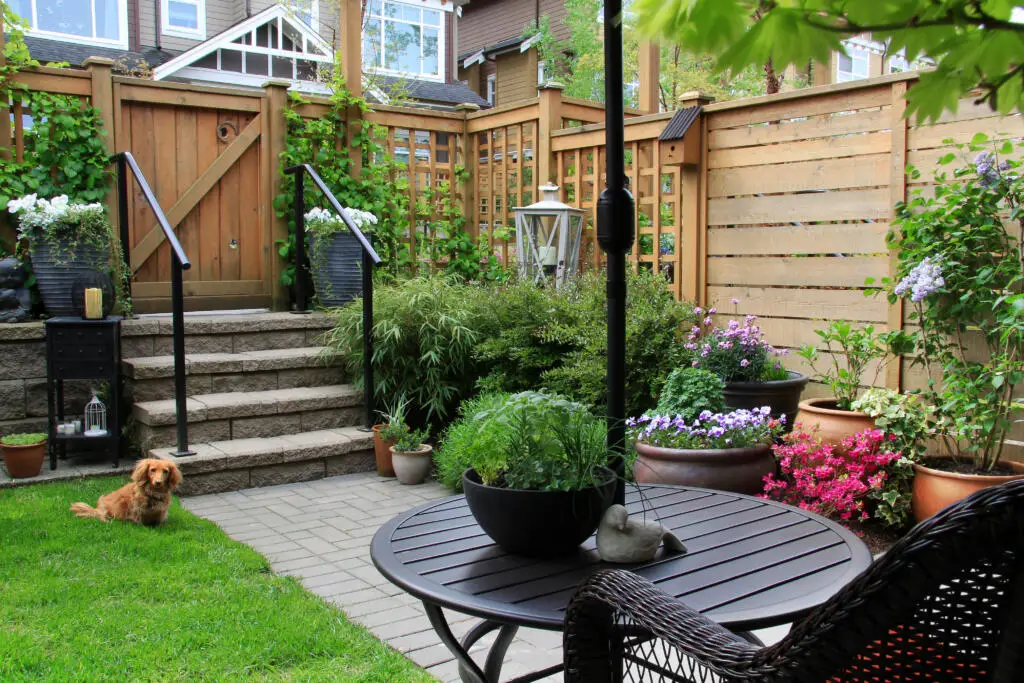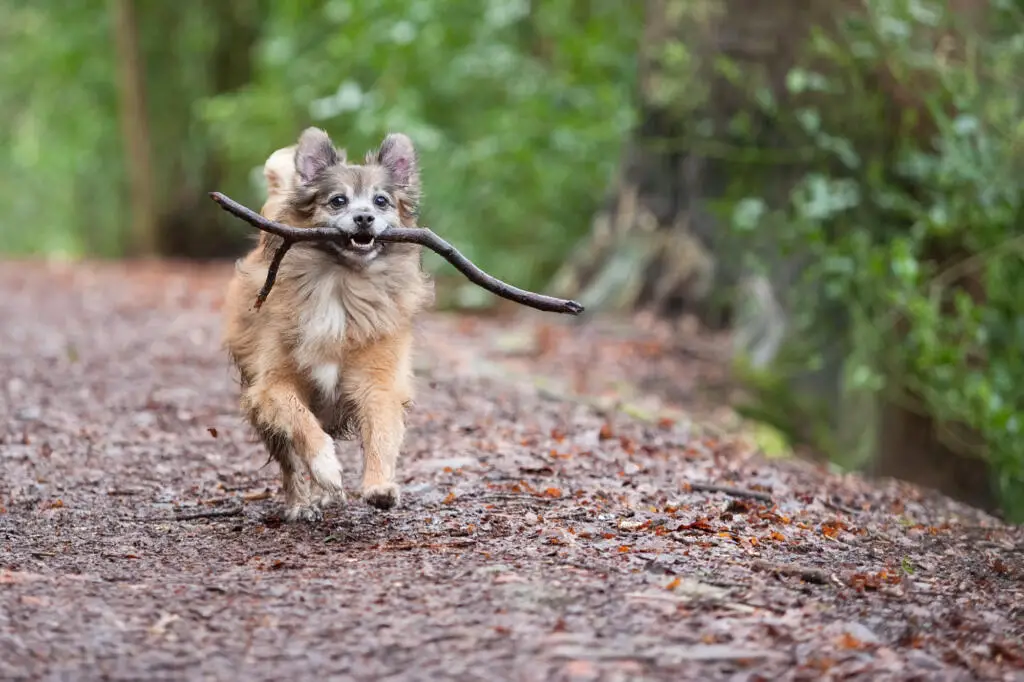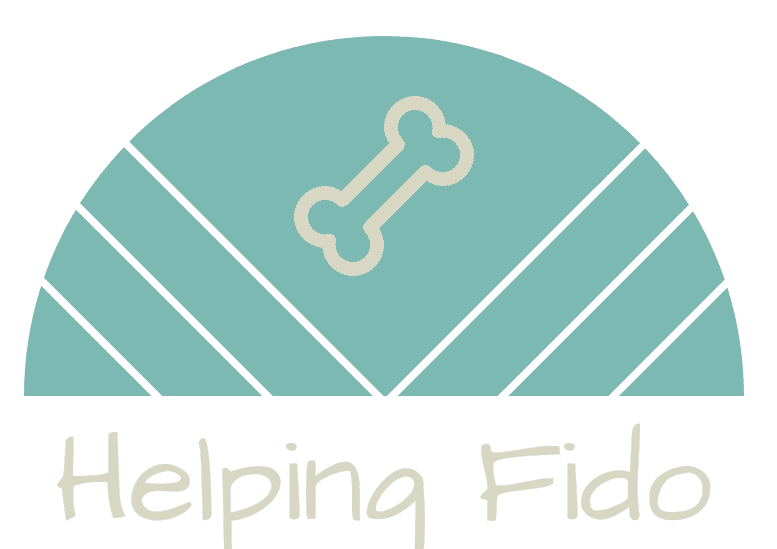Furry friends are members of the family, no question about that. And just like other members of the family, you want to make sure they’re safe at all times.
That means dog-proofing your home … your entire home. While many owners are conscientious about the dangers indoors, they forget that outdoors is just as hazardous without the proper care and attention to safety. In other words, a dog friendly backyard is paramount.
If you’re looking for dog friendly backyard ideas on a budget, we’ve got you covered. This post will take a look at pet safety outside, creating comfy spots for Rover to rest, and how to train your pup to enjoy outside time throughout their lives.
So grab that notebook with the pawprint design and let’s get started.

Article contents
Prioritizing Pet Safety Outside
A dog friendly backyard entails three basic safety factors: fencing, plant safety, and products. Each of these will take a few hours to a few days to implement, but each is well worth the effort to avoid costly vet bills or a tragic mistake.
The Importance of a Secure Fence
If you want to leave your dog outside off-leash, a fence is a must. It ensures your dogs avoid dogfights or car accidents, and also protects them from potentially dangerous wildlife – think raccoons, coyotes, or mountain lions, depending on your area.
You have multiple choices when it comes to fencing, including:
Traditional Wooden Fencing
Standard fences use wooden posts (usually 4x4s) sunk into the ground, with rails between them to which are affixed flat boards. These may wrap around the entire house or enclose just part of the property. They usually have a gate to the rest of the yard, but not always. This is the most expensive type of fence, but it is also the most private and durable.
Chain Link Fencing
Chain link is much easier to put up than a wooden fence. Most people can do it without the help of a professional, although you still have to sink the metal posts pretty deep to ensure they’re sturdy. If you don’t have the skill to do it yourself, that’s okay. You can hire a professional for this too.
Expect to pay less than for a wooden fence, but you may also have to repair or replace it more often. Plus, chain link gets rusty, so you’ll have to be vigilant about tetanus.
Plastic Fencing
Today’s market offers lots more options than it used to when it comes to affordable fencing. Plastics such as vinyl and PVC (polyvinyl chloride) are becoming much more popular and easier to access. They are cheaper than lumber – the highest-ticket material other than something like wrought iron – but can be fashioned to look like wood.
Sometimes the plastic makes up the frame of a panel and wire is strung in a mesh pattern inside of it, which is a rather attractive design and worth looking into. You can also find very cheap, somewhat temporary fences that use as soft plastic mesh, but these will need to be replaced often.
Invisible Fencing
This type of fence is controversial. It uses an underground wire to mark off the boundaries of the property, so you can maintain an open aesthetic in your yard. The wire is linked to a collar that the dog wears, so that when they run past the line they get a light shock and learn to avoid the area. That’s how it works theoretically.
However, as soon as the dog runs past the fence and gets out of range, the shock stops. To many dogs, this is simply the price of escape. Others become fearful because they’re getting hurt. Many owners prefer to avoid cruelty and potential escapes by choosing a physical option.
Plant Safety in Your Backyard
Next up in creating a dog friendly backyard: plants. Check this list of the most toxic plants to ensure you don’t have any growing in your yard currently and remove them if necessary. This is especially important if you are bringing home a puppy, since they will chew on anything. A truly toxic plant (such as hemlock or mistletoe) can kill them if they eat enough of it.
The good news here is that there are plenty of nontoxic plants that look and smell lovely, create privacy, and require little maintenance. Some of the most dog friendly backyard ideas on a budget include:
- Magnolia
- Fuchsia
- Marigold
- Thyme
- Sunflower
… and many others.
Of course, you’re concerned about your plants as well as your pet! You can keep them safe by grouping them in dedicated spaces and creating paths between them, which your dog will quickly learn to use rather than running through garden beds. You can also create a dog-only run with chain link in one part of your yard if you prefer.
Avoiding Toxic Substances
Those without pets and children are free to keep whatever they like in their yards, so many people aren’t aware when they get a pet that this has to change. True, many dogs will leave most “human” things alone, but others won’t. That’s why you need to take care of dangers such as:
Mulch
Some mulches are highly dangerous to pets. The most toxic of these is made of cocoa beans, which is great for the garden and the environment. Those compounds that are amazing for your plants, though? Not so good for Fido.
“Unfortunately, it also contains toxic compounds known as methylxanthines, specifically theobromine and caffeine,” explains Outdoor Happens. “Dogs can’t metabolize either of these compounds the same way humans can, and even a limited amount can cause vomiting and muscle tremors.”
The truth is, though, all mulches are dangerous. They grow mold, they contain splinters, they expand in the stomach, and so forth. If you need to use one, check the link above for the best types.
Pesticides and Fertilizers
While pesticides are sometimes necessary in the garden, they can be very dangerous to doggos. Even the organic ones often contain strong essential oils or microbial compounds that can prove hazardous. The same goes for fertilizers.
The answer here is not to move the “dangerous” ones somewhere else, but rather to keep all pesticides and fertilizers in a safe space. Put them in your garage on a high shelf, keep them in a locked shed, or move them to a cabinet inside – perhaps in a laundry room or storage closet.
Home and Car Products
Much like the above substances, home and car products might seem mundane, but can lead to tragedy when it comes to dogs, especially curious puppies. Remove from your backyard any waxing products, antifreeze, paint, paint thinner, and even rags or paint sticks that may contain chemicals.
Again, it’s best to take a totalitarian approach. Do a thorough sweep and move everything meant for the home or car to a safe, locked space.

Creating Dog-Friendly Play Areas on a Budget
Now for the fun part! Turning your yard into a pet paradise is the best way to ensure your dog spends tons of time outside. This will keep your home cleaner, reduce the amount of time you have to spend exercising your pet, and give you a break from puppy care when pets are younger.
Let’s discuss rest areas, play areas, and yes … safety. Here are some dog friendly backyard ideas on a budget that will make everyone happy.
Providing Adequate Shade and Shelter
First up: make sure your dog has somewhere to rest when they’re tired or it gets hot. Leaving dogs in the hot sun all day can lead to heat stroke, which is potentially fatal. Even when it isn’t, you may have to take them to the vet for treatment and fluids, which is expensive.
You’ll also need somewhere a dog can go to get out of the rain, especially if they aren’t allowed inside whenever they feel like it. The easiest solution here is a doghouse. It provides shade and shelter from the weather as well as a safe retreat when your dog needs a little downtime.
However, dog houses do get hot in summer, as well as in spring and fall if you live in a warm climate. Ideally, you can also provide your pet with an area shaded by a tree or your home, which will stay much cooler than a doghouse in the sun. If not, take them inside during the heat of the day.
Comfortable Resting Areas
A fun and friendly backyard also includes comfortable places for your dog to lie down. Canines need between 12 to 14 hours of sleep a day. About 25 percent of that sleep happens during the day, which means they’re going to need a bed outside if you want them to stay there long-term.
Consider building a patio near the backdoor on which you can place a bed, water bowl, and basket of toys for them. This doesn’t have to cost a ton of money. You can pour a little cement in a small area or build it from cheap cement pavers.
If you want to take the easy route, simply stick a dog bed into their house or kennel. Again, though, make sure it’s shaded if you want them to use it during hot midday hours.
Water Features for Dogs
Water safety is also a big one. While splash zones make dogs really happy if appropriately constructed, standing water can also prove fatal for puppies. Dogs, like humans, have to learn to swim. Until you teach them, they’re in danger of drowning just like little kids.
If you have existing decorative water features, make sure you block them off until your dog is old enough to learn to swim or tall enough to stand up in them with their head above water.
Want to give your pup somewhere fun to play during the hot months? Many dogs love a wading pool, which you can get relatively cheaply at any big box store. Sprinklers and dog friendly ponds are also a win.
Just make sure when you give them water access that you are there to monitor it or that it’s quite shallow. Some dogs do get seizures, and were they to get one in the water with no one around to help, they could drown.
Training Your Dog for the Backyard
Training is an important aspect of teaching your dog to respect the limits of your yard. When they’re young, you should go out with them a lot. Walk them around the boundaries of your yard and give them time to explore, responding immediately to inappropriate behavior such as digging. Over time, they’ll learn to avoid these behaviors even when you aren’t there.
You can also teach your pet to love your dog friendly backyard by exercising them out there. Throw a ball, Kong, or Frisbee to them in your yard so that they associate it with a safe, fun area. This will make them more likely to respect it and want to spend time there.
Lastly, many pet owners find that they’re happier when they train their animal where to go to the bathroom. Respond quickly to No. 1 or No. 2 in areas of the yard that you want to keep clear of waste, telling them no and leading them immediately to the area you do want them to go. Over time, they’ll get it.
Dog-Friendly Backyards for Fun and Profit
Okay, we oversold it a little there … unless you’re enrolling your dog in a show with a large grand prize, there’s not much profit in creating an outside pooch paradise. That doesn’t mean you shouldn’t, though: keeping your yard safe for your animals gives you peace of mind and lets them have more of that sniffy fun that dogs just love.
We can’t wait to see how you put the above ideas for safety, fun, and training to use. Let us know how it goes!
